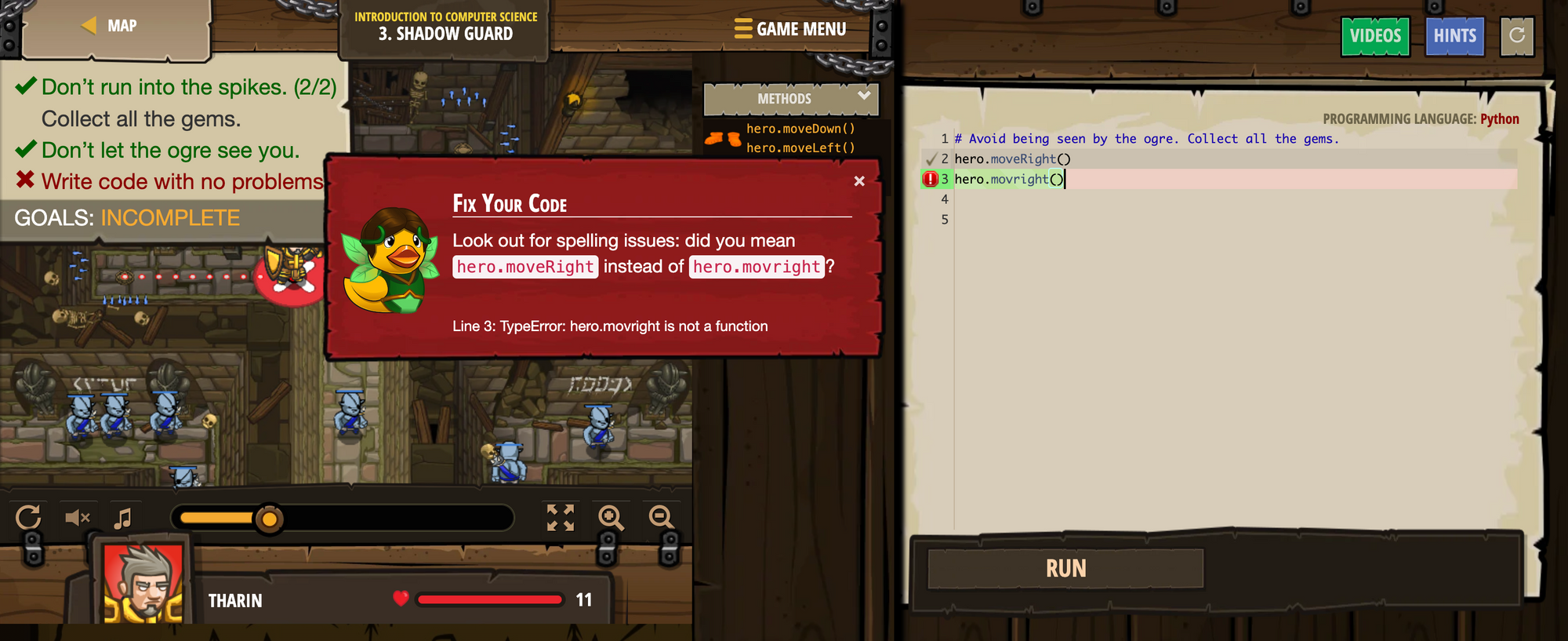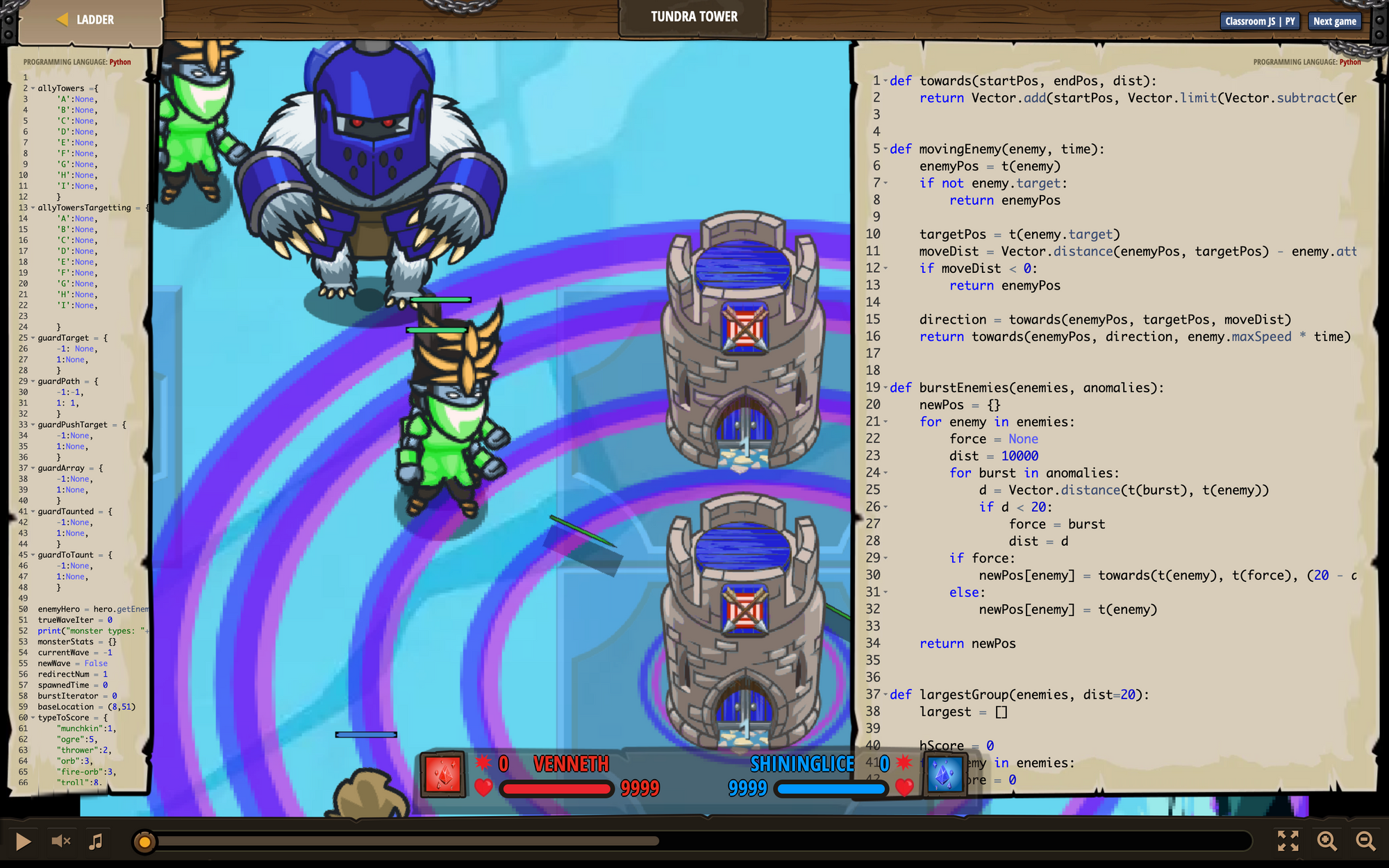The exponential growth of esports is undeniable. Projections for 2022 show revenue set to eclipse $1.38 billion and the global esports enthusiast audience expected to reach 262 million. As competitive coding is now one of the fastest-growing segments in esports, we want to empower educators to fully explore its potential in the classroom.
Schools have begun to recognize the value of esports, with more than 8,600 US high schools having started video-gaming teams since 2018. And while gameplay certainly delivers positive outcomes for students—emphasizing teamwork, strategic thinking and social-emotional development—educators don’t traditionally consider button mashing an academic pursuit.
As competitive coding is now one of the fastest-growing segments in esports, we want to empower educators to fully explore its potential in the classroom.
The CodeCombat AI League takes a unique approach. Players must program a backend strategy and use their coding and problem-solving skills to outsmart competitors. It’s as much game development as it is gameplay. The best of these young coders are learning to use code creatively and developing a tangible skill set that they will use in future careers.
A Foundation of Game-Based Learning
Founded in 2013, CodeCombat was born from a simple idea: Make learning to code engaging and accessible to all. Since then, our game-based learning platform has been used to teach over 20 million students real-typed Python, JavaScript and C++ coding languages through the power of play.
“The RPG-like gameplay is paired with a scaffolded curriculum and teaching resources to guide learners through mastery of foundational programming concepts before moving on to more complex coding,” explains Charlotte Cheng, CodeCombat’s Lead Curriculum Developer. “Each level challenges the player to type the code necessary to advance their hero and achieve specific gaming goals.”
Taking those skills into an open arena environment, players must control the head-to-head action with code. The gameplay creates instant engagement and motivates learners to quickly level up their coding skills.

The Players’ Journey
So, how does one go from no coding experience to competing in one of the largest global competitive coding tournaments? It sounds daunting, but CodeCombat’s scaffolded approach to developing coding skills supports new learners. And the best part is educators don’t need experience coding either. The game does the heavy lifting, while the included lesson plans and student-facing lesson slides make in-classroom implementation turnkey and enjoyable.
Students can start as early as upper elementary school with programs like Ozaria, a narrative adventure game that sets a foundation of core computer science (CS) concepts. The transition to the more advanced CodeCombat platform is easy, and players can quickly advance to competitive head-to-head arenas, which are built into the curriculum.
The CodeCombat AI League is the first of its kind. Part artificial intelligence (AI) battle simulator and part code engine for learning real Python and JavaScript, it’s redefining what an esport can be and giving the next generation of engineers a platform to showcase their creative coding abilities.
Learning the language of code is not unlike learning any other language. To communicate, one must develop an understanding of vocabulary, syntax and structure.

How Competitive Coding Competitions Work
“Coding competitions or hackathons are not new,” says Nick Winter, CodeCombat’s CEO, “but our drive to evolve the format has led us to develop the CodeCombat AI League, a unique esport that turns competitive coding into the spectacle it deserves to be.”
With a basic knowledge of coding, anyone can step into the arena. Code powers the strategies and tactics in battle. So, instead of directional keys or a joystick, players write the code that informs the kinds of heroes, buildings and resources they need to best their opponents.
Players then run test matches against competitors, allowing the AI to simulate hundreds of asynchronous battles on the global leaderboard in seconds. Players can also refine their code at any time, rerun the battle and improve their rankings for the season final championship.
Creative Coding Is the Future
Learning the language of code is not unlike learning any other language. To communicate, one must develop an understanding of vocabulary, syntax and structure. Those who master a new language are able to find interesting combinations that convey deep meaning and purpose. And with code, there are poets among us.
To make it to the top of our leaderboard, competitors need to be creative in their use of advanced coding methods. A 15 year-old going by the username Shininglice has dominated the competitive coding league since its launch in 2021. Having played CodeCombat since the age of 10, he’s finished first overall three times, never losing a single match, and developed some of the most creative coding strategies we’ve ever seen.
This past tournament, ending in April 2022, saw 41,000 competitors vying to end Shininglice’s winning streak. Demonstrating a high level of mathematical creativity, Shininglice’s code informed his heroes to adjust dynamically based on dozens of battlefield conditions—yes, he basically programmed AI right into his forces. His first, and only, loss came at the hands of Venneth, who has been coding since the age of 13 and has aspirations for a career in CS. In contrast to Shininglice, Venneth’s code was written as an exhaustive set of house rules, which was optimized for every possible battle situation that could arise.
“The ingenuity we’ve seen out of these young coders is outstanding,” enthuses Valentin Briukhanov, AI League Design Architect. “I designed these arenas, but the code that some of these players are generating, I never could have imagined. We’ve only just scratched the surface of what competitive coders can achieve and are excited to see what future seasons of the AI League will evolve into.”
Preparing a generation of programmers who can think creatively about code and problem solving in non-traditional ways opens up so much opportunity.

It’s important to note that these young coders are outwitting professional programmers and others with well over a decade of experience. They’ve proven that there is no age requirement when it comes to mastering one’s coding capabilities. The limitless potential of code-controlled gaming is just now starting to be realized. With proper access and tools, young coders will revolutionize the esports landscape.
Preparing a generation of programmers who can think creatively about code and problem solving in non-traditional ways opens up so much opportunity. As the need for more CS professionals in every aspect of industry grows, so does the complexity of the challenges they are being asked to solve. Innovation will only come from those who push the boundaries of possibility.
Teachers, contact our team to learn how you can inspire your students to join the next wave of creative coders!

